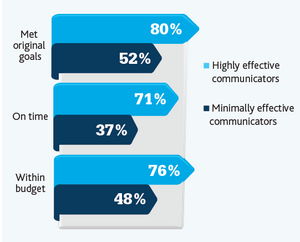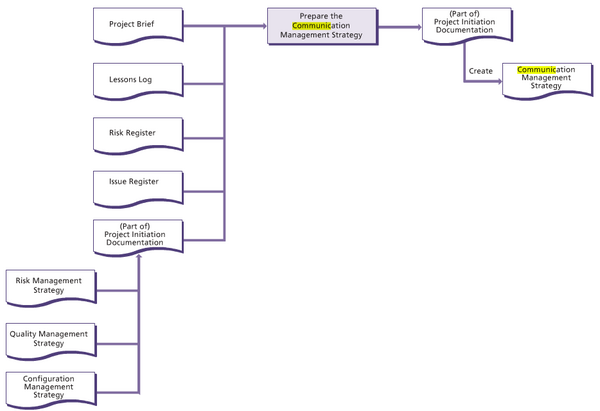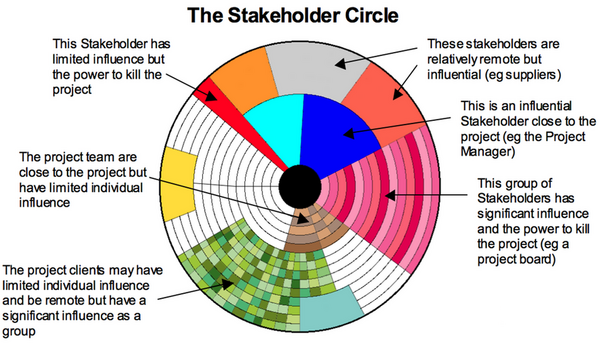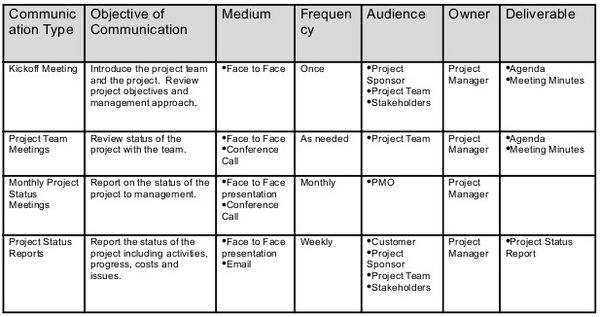Communication in Project Management
In these rapid times of extensive consumerism and competition, organizations are forced to deliver their products more effectively and efficiently in order to meet the growing requirements. Amongst all other required plans and actions, there lies project management, playing an essential role in successful business development, product design, construction, and even at everyday life of an individual. There are numerous types of projects with different project management techniques and strategies, but the backbone is the communication. In fact, more than half of the projects result in being unsuccessful, and one of the main causes of failure is poor or insufficient communication. A project can have well-defined goals, structure, timeline and stakeholders, but it all might just remain in paper if there is no communication plan between them. Communication is one of the biggest issues in the activities that organizations face today, and project management is no exception. Therefore, this article examines different methodologies behind the successful communication management strategies within project management.
Contents |
EFFECTIVE COMMUNICATION IN PROJECT MANAGEMENT
Despite of its form, effective communication serves as a bedrock of business. Communication build trust among project teams, stakeholders, executives and customers. Among organizations, which are considered as highly effective communicators, 80 percent of projects meet original goals, versus 52 percent of their minimally effective competitors, according to PMI (6). One out of five projects is unsuccessful due to ineffective communications. Usually the lack of effective communication dramatically increases the risk projects face. Even though the most managers are aware of communication gap, not all of them succeed in reducing it. In order to overcome this issue, organizations must help everyone to say the right things to the right people in the right channels, and it should be a part of the project culture. Moreover, communication does not end here. Even if the project is finished, team leaders and project sponsors are still responsible for communicating with end users and business unit managers about what has been accomplished and what value is brought to the organization. According to PMI, the effectively communicating organizations are nearly twice as likely to use formal project Communication Plans and Strategies.
According to PMI (3), there are five action steps to improve communication:
- Position communication as a strategic function. The communication must not be positioned as a main task, but more like a context of achievements, in order to avoid the risk of being too focused on the task instead of big-picture goal.
- Define the target. Any group that is left out can turn from a possible supporter into a detractor.
- Make it a group effort. Everyone should be involved in the communication process to make it work correctly.
- Mix it up. By integrating variety in messaging style, timing and channel, organizations ensure everyone can access the information they need, when they need it.
- Get outsider’s opinion. It brings objectivity into the plan and a project team closer to reality.
COMMUNICATION MANAGEMENT STRATEGY IN PROJECT MANAGEMENT
A Communication Management Strategy is done in the project initiation phase and is a document, spreadsheet or a mind map, describing frequency and means of communication between parties within or outside the project. It controls the bi-directional flow of information with stakeholders, thus encouraging their engagement. PRINCE2™ (1), recommends the following ingredients of the Communication Management Strategy:
- Introduction
- Communication management procedure
- Tools and Techniques that will be used
- Records that will be kept
- The ways of reporting the performance of the communication management procedure
- Timing of communication activities
- Roles and responsibilities for communication activities
- Stakeholder analysis
- Quality assessment
The purpose, objective and scope are defined in the introduction, as well as the responsible for the strategy. Communication procedure is description of communication methods that are to be used. It accentuates any deviations from the program management standards. Tools and Techniques refer to any communication tools that may be used for each step of communication. Records describe the required logging of communication activities, as well as where to store them. Reporting describes any needed reports of communication process, including their purpose, timing and recipients. Timing of communication activities describes when the formal communication activities need to take place. Timing also describes when audits of communication methods’ performance need to take place. Stakeholder analysis is a critical component of any communication strategy.
Additionally, the Communication Management Strategy can include or have links to Corporate Communication Policies, Rules for Disclosure, Project Management Team’s structure, Risk Management strategy, Quality Management strategy, information about facilitated discussions or workshops with stakeholders.
The communication Management Strategy aims on both internal and external communications. The strategy must specify the details about how the project management team is going to send and receive information from wider organizations and stakeholders involved or affected in the project. The Stakeholder engagement procedure should also be included as a part of the Communication Management Strategy; it should state the stakeholder types, desired relationships and key messages, strategies for communication, and methodology to evaluate the communication.
The following actions are needed to generate the inputs for Communication Management Strategy:
- Analyze the Project Brief in order to define if any corporate or program management strategies, standards or practices, regarding the communication, need to be employed.
- Create the Lessons Log by seeking lessons from previous similar projects, corporate or program management, and external organizations, related to communication management.
- Review the Risk Register and Issue Register for the issues associated with communication.
- Identify the Stakeholders and consult them for their information needs, such as desired relationships, key communication messages, desired outcomes from successful communications.
- Establish the information needs associated with the Quality Management Strategy, the Risk Management Strategy and the Configuration Management Strategy.
Figure 2 displays inputs and activities of Communication Management Strategy.
QUALITY OF COMMUNICATION MANAGEMENT STRATEGY
After defining the Communication Strategy, it must be consulted whether it meets the needs of Project Board and corporate program management. The Risk Register and Issue Register must be updated if any new risks or issues have been identified. Project Board should approve the Communication Management Strategy despite of a likely preference of approving it later as a part of the Project Initiation Documentation. Communication Management Strategy is evaluated upon certain quality criteria. All stakeholders must have been identified and consulted upon their communication requirements. There must be an agreement from all stakeholders about the content, frequency and methods of communication, furthermore, the common standard for communication has been considered. The resources to carry out any identified communication must be allowed for every stage of the project. If the project is a part of a corporate program, the communication channels and reporting structure to the program must be designated.
STAKEHOLDER ANALYSIS
According to the Project Management Institute (PMI), the term project stakeholder refers to, ‘an individual, group, or organization, who may affect, be affected by, or perceive itself to be affected by a decision, activity, or outcome of a project’. Project stakeholders are ones having interest in a particular project. They can be inside or outside of the organization. They can sponsor the project, they can be interested in benefits of a successful project, and they might have positive or negative influence to the project. Not all of them might be aware that they actually are the stakeholders of the particular project. Important is to define and engage as many as possible different stakeholder groups, including definition of the actual individuals. The stakeholder examples can be project leaders, customers, external consultants, product user groups, product testers etc. In order to benefit of the stakeholders’ activity, project stakeholders’ community can be designed and enhanced by using numerous techniques, “Stakeholder Circle” (2) being one of them. It is an online project management tool, which helps to engage the right people in the right way. It can be used to identify stakeholders and understand their needs, as well as prioritize them and map their profiles. It also is a dynamic tool, which makes it possible to monitor changes over time by updating major change points of the activity. The tool is visualized in the figure 3.
The input of the Stakeholder Circle is a stakeholders’ list developed by the project team, including roles, requirements and significance of each one. The tool prioritizes stakeholders and visualizes the top 15 according to their designated power, proximity and urgency. It displays their order of importance in a form of a radar. The project team must ensure that the expectations of key stakeholders are understood, acknowledged, and managed. The technique provides assessment of each stakeholder’s support and receptiveness to messages regarding the project, thus providing the foundation to develop the Tailored Communication Plan. After the aforementioned plan is developed, the project team can concentrate on monitoring effectiveness by mapping changes in the levels of support and receptiveness of each stakeholder, and eventually evaluate whether the communication plan produces the expected results, or should it be updated.
Other relevant stakeholder control techniques can be explored in the article Stakeholder Analysis (http://apppm.man.dtu.dk/index.php/Stakeholder_Analysis).
COMMUNICATION PLAN
Communication Management Plan is an activity of Project Initiation Documentation, and thus, a part of Project Plan. Although Communication Plans should be customized to suit the particular organization, it typically defines WHAT needs to be communicated TO WHOM, HOW often, in WHAT FORMAT, and WHY they are needed. Formal Communication Plans allow organizations to target efforts so the right people get the right message in the right channel. It defines communication responsibilities as well as it fosters the explicit understanding of the project’s strategic benefits to all stakeholders at every stage of the project.
The importance of a Communication Plan is simple. The communication roles, responsibilities and governance must be clarified, otherwise, the people will focus in different directions. In theory, it is not difficult, but the challenge comes in sticking to the plan consciously, which requires a constant effort.
REFERENCES
1. Office Of Government Commerce (2009) “Managing Successful Projects with PRINCE2™ ”, pp. 150 – 240
2. http://www.stakeholder-management.com/
3. PMI (2013) “Communication: The message is clear” White Paper
4. Communication Management Strategy template: https://www.hashdoc.com/documents/21812/prince2-communications-management-strategy
5. PMI, 2013 “Pulse of the Profession™ In-Depth Report: The Essential Role of Communications



